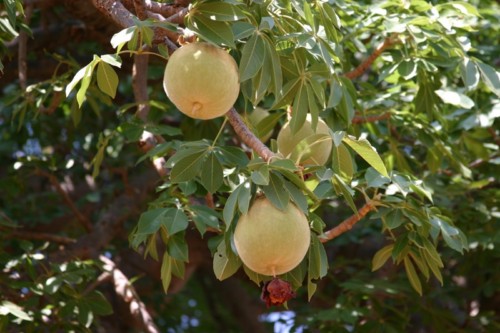| |
Baobab (Adansonia)

|
Other names include boab, boaboa, tabaldi, bottle tree, upside-down tree, and monkey bread tree.
All Baobabs are deciduous trees ranging in height from 5 to 20 meters. The Baobab tree is a strange looking tree that grows in low-lying areas in Africa and Australia. It can grow to enormous sizes and carbon dating indicates that they may live to be 3,000 years old. One ancient hollow Baobab tree in Zimbabwe is so large that up to 40 people can shelter inside its trunk. Various Baobabs have been used as a shop, a prison, a house, a storage barn and a bus shelter. The tree is certainly very different from any other. The trunk is smooth and shiny, not at all like the bark of other trees, and it is pinkish grey or sometimes copper coloured.
When bare of leaves, the spreading branches of the Baobab look like roots sticking up into the air, rather as if it had been planted upside-down. Baobabs are very difficult to kill, they can be burnt, or stripped of their bark, and they will just form new bark and carry on growing. When they do die, they simply rot from the inside and suddenly collapse, leaving a heap of fibres, which makes many people think that they don't die at all, but simply disappear.
An old Baobab tree can create its own ecosystem, as it supports the life of countless creatures, from the largest of mammals to the thousands of tiny creatures scurrying in and out of its crevices. Birds nest in its branches; baboons devour the fruit; bush babies and fruit bats drink the nectar and pollinate the flowers, and elephants have been known to chop down and consume a whole tree. A Baby Baobab tree looks very different from its adult form and this is why the Bushmen believe that it doesn't grow like other trees, but suddenly crashes to the ground with a thump, fully grown, and then one day simply disappears. No wonder they are thought of as magic trees.
The Baobab tree has large whitish flowers which open at night. The fruit, which grows up to a foot long, contains tartaric acid and vitamin C and can either be sucked, or soaked in water to make a refreshing drink. They can also be roasted and ground up to make a coffee-like drink. The fruit is not the only part of the Baobab that can be used. The bark is pounded to make rope, mats, baskets, paper and cloth; the leaves can be boiled and eaten, and glue can be made from the pollen.
Fiber from the bark is used to make rope, baskets, cloth, musical instrument strings, and waterproof hats. While stripping the bark from the lower trunk of most trees usually leads to their death, baobabs not only survive this common practice, but they regenerate new bark. Fresh baobab leaves provide an edible vegetable similar to spinach which is also used medicinally to treat kidney and bladder disease, asthma, insect bites, and several other maladies. The tasty and nutritious fruits and seeds of several species are sought after, while pollen from the African and Australian baobabs is mixed with water to make glue.
Along the Zambezi, the tribes believe that when the world was young the Baobabs were upright and proud. However for some unknown reason, they lorded over the lesser growths.The gods became angry and uprooted the Baobabs , thrusting them back into the ground, root upwards. Evil spirits now haunt the sweet white flowers and anyone who picks one will be killed by a lion. One gigantic baobab in Zambia is said to be haunted by a ghostly python. Before the white man came, a large python lived in the hollow trunk and was worshipped by the local natives. When they prayed for rain, fine crops and good hunting , the python answered their prayers. The first white hunter shot the python and this event led to disastrous consequences. On still nights the natives claim to hear a continuous hissing sound from the old tree.
In the Kafue National Park in Zambia, one of the largest Baobabs is known as 'Kondanamwali' - the tree that eats maidens. This enormous tree fell in love with the four beautiful girls who lived in its shade. When they reached puberty, they sought husbands and made the tree jealous. One night, during a raging thunderstorm, the tree opened its trunk and took the maidens inside. A rest house had been built in the branches of the tree. On stormy nights, it is the crying of the imprisoned maidens that make people inside tremble - not the sounds of the wild animals.
Along the Limpopo, it is believed that when a young boy is washed in water used to soak baobab bark, he will grow up into a big man. Some native beliefs have proven to have a scientific basis. Natives believe that women living in kraals where baobabs are plentiful have more children than those living outside baobab zones. They eat soup made from baobab leaves, which is rich in vitamins. This compensates for any deficiency in their diet. Doctors have confirmed that this indeed brings about a higher fertility rate.
The African bushman has a legend that tells of the god Thora. He took a dislike to the Baobab growing in his garden, so he threw it out over the wall of Paradise on to Earth below, and although the tree landed upside-down it continued to grow. It is not surprising that such a strange looking tree should have superstitions linked to it. Some people believe that if you pick a flower from a Baobab tree you will be eaten by a lion, but if you drink water in which a Baobab's seeds have been soaked you will be safe from crocodile attack. Certain tribes in the Transvaal wash baby boys in water soaked in the bark of a baobab. Then, like the tree, they will grow up mighty and strong.
Baobabs are widely distributed in belts across Africa. They also grow in Madagascar, India, Ceylon and Australia. They grow in many areas of Zimbabwe. In the Northern Province they are found between the Limpopo and the Zoutpansberg range. Messina is indeed a Baobab town. There is a famous `halfway Baobab' between Louis Trichardt and Messina, a reservoir from which many have drawn. Baobabs seem to prefer hot, sandy plains.
These are the healing therapeutic properties of baobab oil.
•Emollient - It is an excellent moisturizer for the skin.
•Insulator - It protects the skin from excessive high and low temperatures.
•Rejuvenator - It promotes rejuvenation of skin cells.
•Non-siccative - It does not dry for a long time.
•Cicatrizant - promote wound healing.
•Antioxidant - It prevents the skin from free radical damage.
•Anti-Inflammatory - because of the presence of omega fatty acids in it.
The biggest use of baobab oil is as a cosmetic agent. One can use it directly on the skin, or combine it with other natural ingredients, like essential oils to impart certain benefits.
As a Massage Oil Baobab oil has a really different texture that most other oils. One can use it as massage oil to get silky, smooth skin. The massage is easily facilitated because of this oil. Massage with this oil is good for dry, damaged skin. It helps the skin to restructure and heal itself. This way, it can help to heal dry skin patches. It is quickly absorbed into the skin. However, it does not leave the skin completely dry because of its non-siccative property.
Home Remedy for Stretch Marks Baobab oil is a nice home remedy for stretch marks. Regular application on area affected by stretch marks reduces the appearance and depth of these marks. It is possible that the oil stimulates collagen and elastin synthesis under the skin to heal the stretch marks. Similarly, it can be used to heal wound scars, like post surgical scars.
As a Daily Moisturizing Lotion After the shower, apply a small amount of baobab oil on the skin. This helps to lock in the moisture. The oil is readily absorbed, thus leaving a non greasy feeling within a few minutes. Alternatively, one can add it to a moisturizing lotion to increase its effectiveness. Chapped Lips Baobab oil is naturally great for chapped lips. Just a small amount of oil applied to the lips gets rid of the chapped lips condition.
Hair Conditioner Baobab oil is heated gently and then applied on the scalp for a hot oil conditioning. Cover with a shower cap for a few hours and then wash it off. This leaves the hair soft and noticeably silky. It also adds some volume to the hair. Applying baobab oil to the hair protects them from damage by sun and free radicals which leaves the hair separated, damaged and frizzy. Nail Care Soak the hands and feet in baobab oil. It makes them soft and easy to take care of. This is helpful in mild ingrown toenail as well, as the nail becomes soft and easy to pull out. This nail treatment prevents them from unwanted breakage. Dental Care Baobab oil is traditionally used to heal swollen, inflamed gums. It can be massage directly on the gums to protect them from inflammation.
Baobab oil is safe to apply undiluted on the skin, because it is a fixed oil. It has not got volatile organic compounds (VOCs). However, this oil is not deemed fit for internal consumption. It has been found to contain anti-nutritious compounds. These are Cyclopropenoid fatty acids (CFPA). In some baobab oil products, these compounds are removed and that makes it edible. Cooking with this oil can also lead to generation of such harmful compounds through chemical changes in the original fatty acids. Therefore, it should be used only as a topical agent. Interactions There is no data on the interactions of baobab oil with topical or internal medication.
Baobab oil contains almost equal proportion of saturated fats:
•Saturated fats
•Monounsaturated fats
•Polyunsaturated fats
Baobab Oil also contains three somewhat exotic fatty acids, which are rare among other oils.
•Malvalic Acid
•Sterculic Acid
•Dihydrosterculic Acid
Their proportion varies depending on the variety of Adansonia tree seeds used for getting the oil. This oil contains high amounts of omega - 6 ( linoleic ) and omega- 9 ( oleic acid ), but hardly any omega-3 ( alpha-linoleic acid ). This disproportion may lead to a pro-inflammatory response when this oil is ingested.
Vitamins and Minerals Baobab oil possibly contains some vitamins and minerals, like Vitamin E, Vitamin A ( as beta carotene ), Vitamin K . It also contains phytosterols, like campesterol, cholesterol, avenasterol and stigmasterol.
Baobab oil has a strong resistance to rancidity. It should however be kept away from light. This oil is used for topical purposes. For using as cooking oil, one should get an oil from which the anti-nutrients have been removed. Baobab oil is a somewhat exotic oil with a silky texture which is sure to surprise many people. It smells good and is nice for general skin care.
Disclaimer: The information presented herein is intended for educational purposes only. These statements have not been evaluated by the FDA and are not intended to diagnose, cure, treat or prevent disease. Individual results may vary, and before using any supplements, it is always advisable to consult with your own health care provider.
|
|


















